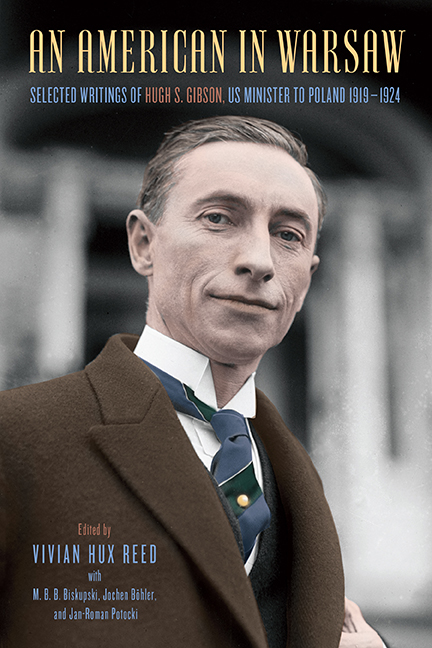Book contents
- Frontmatter
- Dedication
- Contents
- List of Illustrations
- Foreword
- A Few Things about My Father
- Acknowledgments
- Chronology
- Introduction
- 1 A New Observer in a New Poland: 1919
- 2 A Wild Ride: 1920
- 3 Aftermath and Rebuilding: 1921
- 4 A Wedding and a Funeral: 1922
- 5 Stabilization: 1923
- 6 Changes in the Wind: 1924
- Epilogue
- List of Publications by Hugh S. Gibson
- Rochester Studies in East and Central Europe
- Selected Bibliography
- Index
Introduction
Published online by Cambridge University Press: 09 June 2021
- Frontmatter
- Dedication
- Contents
- List of Illustrations
- Foreword
- A Few Things about My Father
- Acknowledgments
- Chronology
- Introduction
- 1 A New Observer in a New Poland: 1919
- 2 A Wild Ride: 1920
- 3 Aftermath and Rebuilding: 1921
- 4 A Wedding and a Funeral: 1922
- 5 Stabilization: 1923
- 6 Changes in the Wind: 1924
- Epilogue
- List of Publications by Hugh S. Gibson
- Rochester Studies in East and Central Europe
- Selected Bibliography
- Index
Summary
In the spring of 1919, Paris felt like a place of new possibilities. World War I, which had embroiled Europe and much of the world for four years, had ended with the armistice of November 11, 1918. During the following six months, the Paris Peace Conference strove to create a lasting peace. US president Woodrow Wilson inspired both the conference and the world with his idealistic Fourteen Points. Nations would be born and maps redrawn under the Allies’ sweeping vision of a new and better world governed by self-determination. Few peoples welcomed the opportunity more than the Poles in Europe and America.
By March 1919 the Peace Conference was in full swing. Delegates were besieged with lobbyists from every conceivable national group, political party, and business interest. The war had catapulted the United States into a position of influence and power. The American Commission to Negotiate Peace, the US diplomatic corps in Paris, and the military advisers and commissioners, as well as the American Relief Administration, were hard at work and determined to turn as many of Wilson's ideals as possible into realities. One young American diplomat had a hand in each of these powerful groups, and for him Paris in the spring was indeed a new beginning.
Hugh Simmons Gibson (1883–1954) was uniquely positioned to become the first US minister to the Second Polish Republic, an ancient nation newly reestablished after over a century of partition among the three empires dissolved by World War I (Germany, Austro-Hungary, and Russia). Although Gibson is the subject of a memorial volume compiled by his friends and a dissertation devoted to his diplomatic career, his contributions in the diplomatic and humanitarian realms are largely overlooked. This volume presents Gibson's experience during his term as minister to Poland through his writings.
Gibson paints a rich and engaging picture of Poland's first years of recovered independence. To step into Gibson's fiendishly complex world and glean insight from his richly detailed account, some context and scene setting is necessary. A basic knowledge of Poland's history up to this point is foundational to understanding Poland's birthing process beginning in November 1918.
- Type
- Chapter
- Information
- An American in WarsawSelected Writings of Hugh S. Gibson, US Minister to Poland, 1919–1924, pp. 1 - 39Publisher: Boydell & BrewerPrint publication year: 2018



